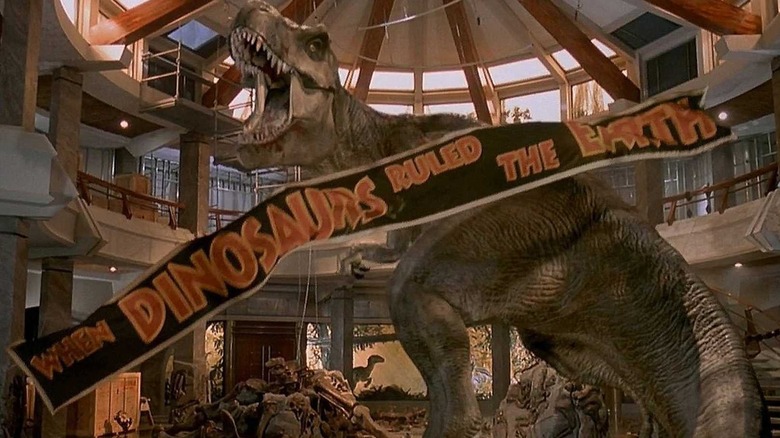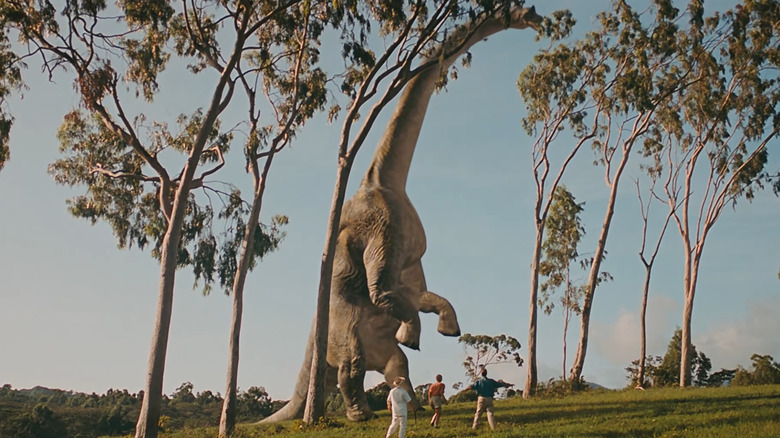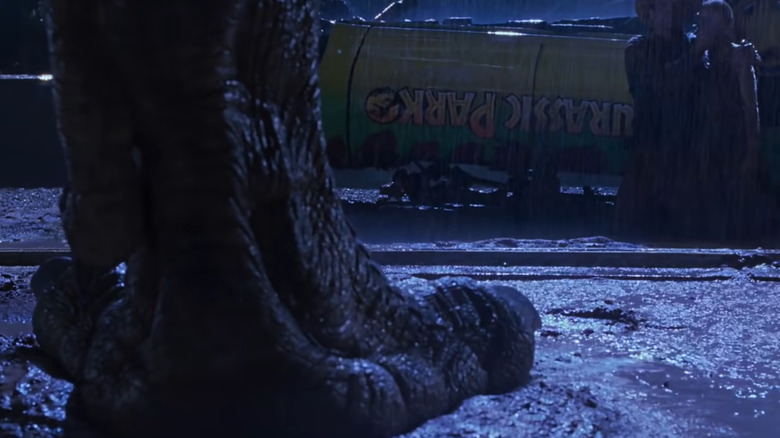Steven Spielberg Wasn't Going To Let Budget Limit The Scope Of Jurassic Park
It's difficult to underestimate just how deeply Steven Spielberg changed the game. The summer blockbuster maestro is responsible for bringing us some of the most iconic visuals the form has ever produced. I certainly can't forget the first time I saw E.T. come to life, or Bruce popping his head out of the water ("Jaws"). The best visual effects balance out with all the other components that make a great film, and Spielberg knew that.
With "Jurassic Park," Spielberg showed us what movies could accomplish. He reinvented the way in which we saw spectacle with an action-adventure thrill ride with dinosaurs that still take our breath away. The string of "Jurassic Park" sequels kept on trying to find new ways to show off the prehistoric creatures, but there's truly nothing like the first time you Iay your eyes on the T. rex bursting out of the electric fence.
To this day, the imagination of the T. rex attack is an impressive piece of filmmaking that makes me feel like I'm under attack by a monster out of time. That is the magic of Spielberg. He has an incredible penchant for spectacle, but sometimes the breath of imagination can prove to be a challenge in getting the exact quality of movie you want based on the budget you've been allotted. Thankfully, Spielberg knew exactly how to handle this dilemma.
'Your imagination, that's the only limit you have.'
When asked by Collider about the challenge of carrying the scope of the dinosaurs from script to screen, "Jurassic Park" co-writer David Koepp ("Stir of Echoes") recounted how Spielberg taught him to never second-guess his imagination:
"I wrote a line in one of my first drafts that said 'The T. rex bursts out of the trees, chases down the Gallimimus, and devours it in a cloud of dust and blood.' I thought, 'Well I love that line, and I'd love to see that.' But I asked Steven, 'This seems impossible to me, should I take it out? Should I do it another way? What are my limitations?' and he said, 'Your imagination, that's the only limit you have. We'll figure it out.'"
The last part of Koepp's quote is the reason why Spielberg is as respected as he is. You would only be hurting your vision if you didn't try to at least try and reach for the clouds, even if external factors ensure that it's out of your reach.
The special effects industry is in a wildly different place now than it was nearly 30 years ago when "Jurassic Park" was being assembled. I wouldn't exactly call it easier, but more tools are certainly available at a filmmaker's disposal. Whether they use them, or even have access to them, is a whole other story.
CG and practical effects can be best friends
David Koepp continued in the Collider interview by talking about the challenges that came with the illusion of making the dinosaurs move, and how the blending of CG with practical was a risk in and of itself:
"But I knew that the real challenge was running, in the movies if you see a dinosaur and his feet are in the shot it's probably a puppet or one of Stan Winston's creations. If you see the legs and it walks, that's CG, but that's what nobody knew if it would work or not."
There was a point where practical effects such as miniatures, animatronics and stop motion were the dominant methods of bringing larger-than-life creatures to the screen. Even when they looked like an effect, there's always something charming about recognizing that the monster in front of you actually exists. Winston's massive T. rex animatronic is still an intimidating visual.
But what Spielberg, Winston, Phil Tippett, and the folks over at Industrial Light & Magic did is set a new standard that is still felt within the industry. The composite blend of animatronic puppetry and fully CG dinosaur models showed an industry that both technologies can coexist, with one complementing the other to create the illusion that they just straight-up made a dinosaur of their own.
Looking at what Spielberg and Koepp accomplished with "Jurassic Park" is a sobering reminder that you can have one of the best ideas to make into a feature film, but without the spark or imagination of someone who believes in their vision, it's just more Triceratops dung to stack on top of the pile of lackluster summer movies.
"Jurassic Park" is currently streaming on HBO Max, whatever's left of it.


